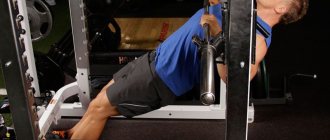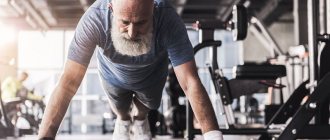Most running enthusiasts at the initial stage of training rarely think about theoretical issues, considering theory boring and unnecessary. And completely in vain. Without understanding what happens in the human body when playing sports, it is impossible to figure out your mistakes and advance the training process to a new level.
Aerobic and anaerobic running
To begin with, we suggest you understand what aerobic and anaerobic running are, how they differ and how they affect the overall training of a runner.
Features of aerobic exercise
To achieve results, exercises are used, the main source of energy for which is oxygen. That is, such training is aimed at strengthening all tissues of the body. They began to be used back in the seventies of the twentieth century, and in modern fitness they occupy an honorable place among the mandatory exercises for maintaining excellent shape and rapid weight loss.
Good to know: scientists have found that it is aerobic exercise that promotes fat burning and control the level of subcutaneous fat*.
Aerobic exercise is:
- all types of aerobics;
- cycling;
- skiing, skating and roller skating;
- swimming;
- running and exercise on a treadmill;
- race walking;
- dancing.
As you can see, the choice is truly impressive: if you wish, you can easily choose a suitable aerobic activity that will not only help keep your body in good shape, but will also bring real pleasure.
Benefits of Aerobic Exercise
Why do all trainers necessarily recommend alternating different types of loads and not forgetting about “oxygen training”? The fact is that aerobic exercise can bring maximum benefits:
- increase endurance;
- reduce the risk of developing cardiovascular diseases;
- remove waste and toxins from the body;
- prevent the development of diabetes and get rid of insulin resistance;
- strengthen bone tissue;
- improve your emotional state and effectively deal with stress;
- improve sleep quality, get rid of insomnia.
And while performing such exercises, calories are consumed well, which starts the fat burning process. As a result, the body loses excess weight faster.
Interesting fact: Arnold Schwarzenegger is a big fan of aerobic exercise, thanks to whom it has become incredibly popular among professional bodybuilders.**
How it works?
During the first twenty minutes of performing any aerobic exercise, the glycogen received by the body throughout the day is quickly burned. And only half an hour after the start of the workout, proteins and fats begin to be consumed. If the workout takes at least forty minutes, then it is not in vain: the ongoing fat burning process continues for another two hours. However, in order for aerobic exercise to help you lose weight faster, you will have to adjust your eating habits:
- give up fast food, store-bought sweets and store-bought concentrated juices;
- reduce the amount of sugar in your diet;
- monitor the balance of proteins, fats and carbohydrates;
- eat more fiber;
- maintain water-salt balance.
If you feel hungry after a workout, you can drink natural yogurt or a glass of Herbalife Nutrition protein shake. These foods will not affect the positive effect, but foods rich in carbohydrates will stop the fat burning process.
Features of anaerobic load
These are intense and short-term exercises with maximum muscle tension. During such training, the body receives virtually no oxygen, resulting in an increase in the amount of energy consumed. The exercises are performed quickly, in several short approaches. Such training includes:
- sprint running;
- fast cycling;
- powerlifting;
- body-building;
- all types of strength training;
- exercises on sports equipment.
In this case, all exercises alternate with short breaks, which allow the body to replenish the lack of oxygen. Such workouts help you quickly get rid of excess weight, disperse congestion, pump up muscles and achieve a beautiful figure relief. However, excessive overload is very dangerous and can cause problems with the respiratory system or cardiovascular system. That is why anaerobic exercise must be performed under the close supervision of a trainer.
Should you run every day?
Running every day is good for your health. A 2022 study found that jogging for 5 to 10 minutes daily at a moderate pace helps reduce the risk of death from heart attacks, strokes and other common diseases ScienceDirect. Running as a Key Lifestyle Medicine for Longevity – Published: 03/30/2017. The study authors also claim that the benefits of running are maximized if you devote 4.5 hours a week to it, but with daily regularity.
A 2014 study reported in the Journal of the American College of Cardiology found that even 5 to 10 minutes of low-intensity running every day was enough to extend life by several years JACC. Leisure-Time Running Reduces All-Cause and Cardiovascular Mortality Risk – Published: 08/5/2014.
- It is important to remember that:
Running is a high-impact strength exercise, and overuse can lead to stress fractures, calf injuries, and more BHC. Running and jogging – preventing injury.
How many days a week to run depends on your goals and fitness level. Incorporating cross-training, strength training, and rest into your running training plan will make you stronger and healthier. Read on to learn more about the benefits and risks of running every day, plus expert tips for making running part of your healthy lifestyle.
The benefits of anaerobic exercise
With the correct implementation of such training, you can achieve excellent results:
- develop endurance;
- get high strength indicators;
- speed up the fat burning process due to large calorie losses during exercise;
- strengthen and enlarge muscles;
- achieve a beautiful relief;
- correct posture and strengthen the musculoskeletal system;
- increase the level of immunity;
- reduce the risks of diabetes;
- increase body tone and get rid of constant fatigue.
For best results, it is recommended to combine anaerobic exercise with proper nutrition. For athletes who choose this method of gaining muscle mass, a diet with an increased amount of protein will be optimal.
Interesting fact: the effect of anaerobic training lasts for thirty-six hours, when metabolic processes continue to be active in the body, promoting fat burning and muscle growth.***
BX
Basal metabolism plays one of the main roles in the process of losing weight. The higher it is, the more efficiently calories are spent; the lower it is, the more the body tends to “store” energy and store it in fats (for more details, see the article “Physiology of Weight Loss”).
| Basal metabolism is the minimum amount of energy required to ensure normal functioning of the body under standard conditions (at rest). |
People with more muscle mass have an increased basal metabolic rate compared to people with less muscle mass.
How it works?
Loads of this type are effective when certain exercises are performed correctly and regularly. Two main factors are involved in the muscle development mechanism.
Anaerobic glycolysis.
During the exercise, the muscles consume their entire supply of oxygen: this is enough for a short-term load lasting no more than twelve seconds. After this, the body begins to consume oxygen, and the load turns into aerobic. However, the entire effect of training rests on glycolysis. In order for a person to perform physical exercise, energy is needed, and the body receives it from the ATP molecule, which is found, among other things, in muscles.
Anaerobic threshold.
This is an indicator of the intensity of the exercise, as a result of which a certain amount of lactic acid exceeds the level of its neutralization. Heart rate measurement can be used to measure this threshold. This will allow you to identify the rhythm of training during which the fat burning process will be most active.
Start at low heart rate
You won’t be able to achieve great results right away and you just have to come to terms with it. Start gradually, almost step by step. Even if your muscles are able to take you to high speed, your heart is not ready for this, since you are unlikely to have given as much time and attention to strengthening your heart muscles as to slender/strong/beautiful (underline as appropriate) legs! Yes, it will be terribly boring, you will walk 5 km in an hour (and this is quite realistic), and during this time the thought of giving it all up will appear in your head more than once or twice! But if you really want to be healthy, strengthen your heart, stay injury-free, and achieve your goals, you will have to get a heart rate monitor and run at a low heart rate (120-140 beats per minute) until you see that as you increase your pace, your the heart still beats steadily.
Start with three workouts a week lasting no more than half an hour. If your heart rate does not allow you to run and even with a light jog rises above 140 beats per minute, go. Try race walking if just walking is boring. Then after a week of training, increase the time and add another 5-10 minutes. Progress will depend primarily on your physical data, but not least on your patience and consistency!
Finally, we offer you a video from the Skirun school, which very clearly and simply explains why it is necessary to start training with a low heart rate.
Anaerobic and aerobic respiration
During training, both options for obtaining oxygen can be used. During aerobic exercise, it is breathing that helps to properly expend energy. Oxygen oxidizes carbohydrates, the lungs actively process this gas and saturate all tissues of the body. As a result, the respiratory system becomes stronger and body weight decreases. What is the difference between anaerobic exercise? To perform exercises, oxygen is not needed: the role of an oxidizing agent is played by substances contained in tissues. That is, the body actually breathes at the cellular level. At the same time, you need to understand that using only one type of load is not an entirely correct solution. If we are talking about training for the sake of rapid weight loss, working out muscles and obtaining beautiful relief, then anaerobic and aerobic techniques must be alternated. Your personal trainer will tell you exactly how. At least for this, it’s worth visiting the gym several times and understanding how your body works under certain types of load.
Why is there no result?
The lack of results indicates three things:
- You are not running slow enough - use your heart rate zone as a guide;
- Your body is under stress - overtraining, lack of sleep, poor nutrition, emotional stress, illness;
- You expect to make a lot of progress too early. Remember the principle of gradualism.
A combination of aerobic and anaerobic exercise
You need to understand that there is no single type of training in its pure form. As we said above, after a maximum of 12 seconds of execution, the exercise turns from anaerobic to aerobic. To achieve maximum effect in training, it is better to choose the optimal set of exercises. However, before starting serious loads, you need to make sure that there are no contraindications:
- diseases of the cardiovascular system;
- gastrointestinal diseases;
- disorders of the kidneys and liver;
- chronic diseases in a state of relapse.
If you are unsure whether an exercise is right for you, it is best to consult your doctor first and then tell your trainer about it. If there are no contraindications, you can choose a program that focuses on aerobic or anaerobic exercise. In the first case, you will be able to lose excess weight faster and strengthen your body. In the second - to achieve a beautiful muscle relief.
Power training
By strength we mean high-repetition training with your own weight, training with weights of various types. During strength training, energy consumption occurs anaerobically, i.e. without the participation of oxygen.
Accordingly, fat oxidation does not occur, but lactic acid is formed. Therefore, strength training itself does not “use up” fat, but strengthens and increases muscle fiber, which, in turn, leads to an increase in basal metabolic rate. The stronger and more massive the muscle fiber, the more energy is spent at rest.
| This is the main factor in reducing the percentage of fat mass from strength training: weight loss does not occur during training, but during recovery after it and in everyday life. |
So, strength training helps reduce body fat by increasing basal metabolism, but can lead to an increase in total body weight by increasing muscle fiber .
High Intensity Interval Training
HIIT is a kind of “arithmetic average” between cardio and strength training.
| This type of training, according to modern research, can provide an increase in physiological indicators in less time than long-term low-intensity exercise, and also have a positive effect on metabolism. |
Many studies indicate a higher level of fat oxidation, i.e.
about a more obvious “fat burning” effect of HIIT compared to aerobic training over the same time. HIIT is also an effective fat-burning workout because oxygen consumption (and therefore calorie burn) remains elevated after the workout .
This type of training puts extreme stress on the body and is suitable for trained people, so you should not practice it more than three times a week , especially since it is in this mode that the maximum effect is manifested.
So, HIIT helps you lose weight in a shorter period of time than other types of training, but this type of training is not suitable for everyone. You should not train in this way without preparation and more than 2-3 times a week.
Contraindications to exercise
In addition to the above list, there are a number of prohibitions. For example, anaerobic exercise is not suitable for beginner athletes. In this case, the trainer draws up an individual training program, which gradually introduces complex, intense exercises on simulators. In addition, anaerobic exercise is strictly contraindicated for pregnant women and people who have recently undergone surgery. Aerobic exercises have a number of differences here too: expectant mothers, on the contrary, are advised to regularly walk and swim. You should check with your doctor about the possibility of resorting to other loads. At the same time, anaerobic exercises are contraindicated during exacerbations of respiratory diseases and in the presence of varicose veins, as well as during rehabilitation after surgical interventions. Remember that ignoring doctors' recommendations does more harm than good. It is worth returning to previous loads after injuries and illnesses gradually.
Diet
No workout will give the desired result if you don’t change your usual diet. What does aerobic or anaerobic exercise diet mean?
- Refusal of fast food, excessively fried, fatty and sweet foods.
- Increasing fiber in your diet: eat fresh vegetables and fruits, preferably with minimal heat treatment.
- Consumption of large amounts of proteins: meat, fish, nuts, dairy products.
- Maintaining water-salt balance: you need to drink at least one and a half liters of clean water daily.
In addition, dietary supplements can be used to increase the body's endurance and maintain overall tone. For example, Herbalife Nutrition's Guarana-based NRG* tablets can help boost your energy levels. To recover after a workout, you can take a Formula 1 protein shake. A large amount of protein will saturate the body and contribute to the fat burning process.










